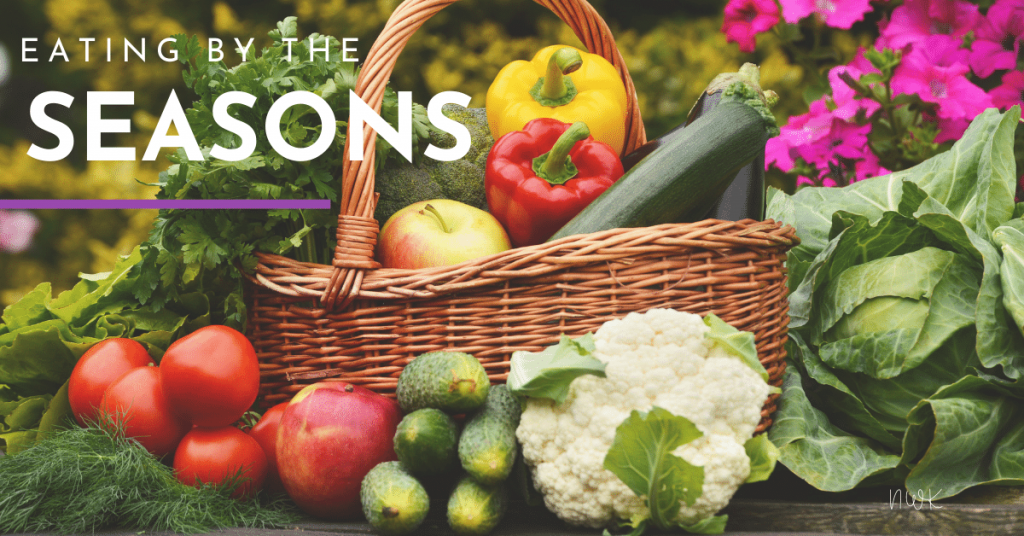Seasonal eating or eating seasonally is purchasing and consuming foods when they are harvested. Seasonal food is fresher, more nutritious, cheaper, and tastier. Eating according to the seasons is fun, simple, and sustainable! Seasonal eating is not only good for you but the environment too. Lastly, eating by the seasons is not all or nothing. Adding seasonal fruits and vegetables to normal shopping and cooking habits is great way to add variety to your diet.

Seasonality
Seasonality and sustainability are different concepts BUT eating seasonally can help you eat sustainably. Sustainable eating is about choosing foods that are healthful to both you and your body as well as the environment.
The Five W’s of Seasonal Eating
Who should eat seasonally? Everyone! What is seasonal eating? When you purchase and eat produce at the time of year when it is naturally harvested. When? Year round! Keep in mind what is available per season depends on where you live. Where? At the farmer’s market, grocery store, or wherever you purchase your produce. Why should you eat seasonally? Variety, quality, freshness, cost, and sustainability. Furthermore, fresh foods are less expensive and at peak freshness and flavor. Eating seasonally is a great way to add color to your diet.
How to Eat Seasonally?
Think local, visit a farmer’s market, get involved with a community supported agriculture program (CSA), check out the produce section of the grocery store, check out food and nutrition bloggers and visit your state’s department of agriculture. Many supermarkets dedicate a portion of their produce section to local, seasonal fruits and vegetables. Some may even provide recipes! Incorporate seasonal produce into your meals and snacks by finding out what is in season, trying new recipes or incorporating them into your favorite dishes. Try a salad or soup using winter fruits and vegetables.
Fruits and Vegetables Currently in Season
New Jersey produces an array of fruits, vegetables, and grains despite being one of the most densely populated states in the United States. (1) New Jersey isn’t known as the Garden State for just any reason! Fun Fact: There are more than 7,000 varieties of apples grown throughout the world and more than 30 are grown in New Jersey! (2) Keep reading to find out what else is in season in New Jersey.
The Garden State
New Jersey is a top ten producer of fruits and vegetables such as eggplant, blueberries, and tomatoes. (1) Drive through parts of NJ and you will find vineyards, horse farms, and produce and livestock farms that stretch for miles. New Jersey grows hundreds of different fruit and vegetable varieties each year. New Jersey has nearly 10,000 farms and 17% of the state is comprised of farmland. (1)
Winter Fruits and Vegetables in New Jersey
After that brief history lesson, what is in season in New Jersey? Fruits, leafy green vegetables, corn, squashes, and tomatoes are just a highlight of local produce available in grocery stores and farmers markets throughout the state. Apples, cranberries, arugula, beets, Bok choy, broccoli, Brussels sprouts, cabbage, carrots, cauliflower, Chinese cabbage, collard greens, garlic, kale, lettuce, leeks, lima beans, mustard greens, okra, onions, parsnips, peppers, potatoes, pumpkins, scallions, squash, sweet corn, tomatoes and turnips are currently available this winter. (2)
Cooking Your Winter Fruits & Veggies
What can we do with our winter fruits? Besides enjoying them raw, we could sauté our apples and pears with cinnamon and nutmeg for a quick snack or dessert. We can combine different varieties of apples to make an apple salad, toss in some cranberries for extra flavor! We can top our breakfasts with seasonal fruits, snack on fruits throughout the day or add them to smoothies, snacks, meals or desserts.
What can we do with our winter veggies? We can eat our vegetables raw or boil, steam, saute, stir-fry, roast, bake, grill or pickle them! Try sauteing potatoes with leafy greens and seasonings for a great side dish. Roast vegetables such as potatoes, broccoli, cauliflower, brussel sprouts and carrots on a sheet pan. Try stuffed squash or sweet potatoes as a meal or side dish. Add leafy greens to a smoothie for extra vitamins and minerals. In addition to smoothies, add vegetables to soups, salads, casseroles, stir-fries or sauces.
Keeping Your Winter Produce Safe
The four principles of food safety: clean, separate, cook and chill. Keep surfaces and utensils clean. Wash all produce before eating not after purchasing, unless eating it immediately. Separate produce from meats and poultry and cold foods from hot foods. When cooking either fruits or vegetables, make sure to cook them to the proper internal temperature. Consider canning or freezing extra produce so you can add it to smoothies and soups throughout the season! View this produce storage guide from UC Davis on how to properly store fruits and vegetables for better taste.

Conclusion
Seasonal eating is good for you, your family, your wallet, and the environment. Even during winter there are so many foods in season in New Jersey. If you do not live in NJ, check out your state’s department of agriculture to find out what is in season in your state. As you enjoy your winter festivities consider how you can incorporate more winter fruits and vegetables into your diet! From soups and salads to sauces and desserts there are many ways to enjoy seasonal produce. Seasonal eating adds color, variety and nutrition to your diet. Winter is not over until March 20th, there is still plenty of time to incorporate winter fruits and vegetables!



I wish I would have seen this earlier in the season! However, I look forward to a Spring Veggy rundown!!!
I have read so many posts about the blogger lovers however this post is really a good piece of writing, keep it up
This is an excellent post I seen thanks to share it. It is really what I wanted to see hope in future you will continue for sharing such a excellent post.
This website is remarkable information and facts it’s really excellent